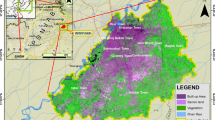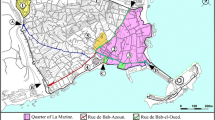Abstract
The author deals with the vegetation of the Himalayas taking his 1957 map as basis of the presentation. This map by way of vegetation first opened insigh into the hitherto unknown landscape structure of the mountain system, thereby revealing, for instance, the phenomeon of the inner valleys and the climatically dry valleys, in particular as well as the areas vegetationwise still unknown. Progress in our knowledge of the vegetation in the Himalayas since publication of the 1957 map is carefully recorded showing, above all, the advancement of our knowledge in Nepal since. In contrast to expectations, research was unable to concentrate on all the gaps in our knowledge as demonstrated on the 1957 map owing to political conditions prevailing.
Similar content being viewed by others
References
Haffenr, W.: Nepal Himalaya: Untersuchungen zum vertikalen Landschaftsaufbau Zentral- und Ostnepals. Erdwissenschaftliche Forschung 12 (1979)
Hesmer, H.: Leben und Werk von Dietrich Brandis (1824–1907). Abhandlungen Rheinisch-Westfaelische Akademie der Wissenschaften, Opladen 1975.
Hou, Hsioh-Yu: Vegetation Map of China, 1:4,000,000. Academia Sinica, Beijing 1979.
Jessen, O.: Die Randschwellen der Kontinente. Petermanns Geographische Mitteilungen Erg. heft 241.205 pp., 32 Plates, 2nd ed., Gotha 1948.
Kleinert, C.: Siedlung und Umwelt im zentralen Himalaya. Geoecological Research 4, Wiesbaden 1983.
Kuechler, A. W.; Sawyer, J. O.: A Study of the Vegetation near Chiangmai, Thailand. Transactions Kansas Academy of Sciences 70, 281–348 (1967)
Miehe, G.: Vegetationsgeographische Untersuchungen im Dhaulagiri und Annapurna Himalaya. Dissertationes Botanicae Vol. 66, Part 1 and 2. Vaduz 1982.
Miehe, G.: Langtang Himal: Flora und Vegetationn als Klimaanzeiger und-zeugen im Himalaya. Diss. Bot. 158. Berlin Stuttgart 1990.
Miehe, G.: Die Vegetationskarte des Khumbu Himal (Mt. Everest-Sudabdachung) 1:50 000. Erdkunde 45, 2, 81–94 1991
Nakao, S.: Ecological Notes. In: Fauna and Flora of Nepal Himalaya; Scientific Research of the Japanese Expedition to Nepal Himalaya, 1952–1953, vol. 1, 278–290. Kyoto 1955.
Nanda, N.: Tawang. New Delhi 1982.
Ohsawa, M. (ed.): Life Zone Ecology of the Bhutan Himalaya. Chiba 1987.
Robbins, R. G.; Smitinand T.: A Botanical Ascent of Doi Inthanond. Natural History Bulletin Siam Society 21, 3–4, 205–227 (1966)
Santisuk, T.: An Account of the Vegetation of Northern Thailand. Geoecological Research Vol. 5, Stuttgart 1988.
Schmidt-Vogt, D.: High Altitude Forests in the Jugal Himal (Eastern Central Nepal): Forest Types and Human Impact. Geoecological Research 6, Stuttgart 1990.
Schmidt-Vogt, D.: Schwendbau und Pflanzensukzession in Nord-Thailand. Alexander von Humboldt-Stiftung Mitt.-Mag. 58, 21–32 (Dezember 1991)
Schweinfurth, U.: Über klimatische Trockentäler im Himalaya. Erdkunde, 10, 297–302 (1956)
Schweinfurth, U.: Die Horizontale und Vertikale Verbreitung der Vegetation im Himalaya. Bonner Geographische Abhandlungen, 20, 12:1–375 (1957)
Schweinfurth, U.: Der Himalaya — Landschaftsscheide, Rückzugsgebiet und politisches Spannungsfeld. Geographische Zeitschrift 53, 4, 241–260 (1965)
Schweinfurth, U.: The Eastern Marches of High Asia and the River Gorge Country Erdewissenschaftliche Forschungen 4, 276–287, Wiesbaden 1972.
Schweinfurth, U.: Der innere Himalaya — Rückzugsgebiet, Interferenzzone, Eigenentwicklung. Erdkundliches Wissen, 59, 15–24, Wiesbaden 1982.
Schweinfurth, U.: Mensch und Umwelt im Indus-Durchbruch am Nanga Parbat (NW-Himalaya). Beiträge zur Süd Asien Forschung 86, 536–559 (1983)
Schweinfurth, U.: Zur Landschaftsgliederung im chinesischtibetischen Übergangsraum. Berliner Geographische Studien 20, 237–249 (1986)
Schweinfurth, U.: Climatically dry valleys in the Himalayas and further east. In: Explorations in the Tropics. Poona 1987.
Schweinfurth, U.: Pinus in Southeast Asia. Beiträge zur Biologie der Pflanzen 63, 253–269 (1988)
Schweinfurth, U.: Chen Weilie: (1984) Vegetation und Landesnatur im südlichen Gaoligong Shan (West-Yunnan). Erdkunde 38, 278–288 (1984)
Smitinand, T.: The Vegetation of Doi Chiang Dao, a Limestone Massif in Chiang Mai, Northern Thailand. Natural History Bulletin of Siam Society, 21, 93–128 (1966)
Stanford, J. K.: Far Ridges. London 1945.
Stein, N.: Coniferen im westlichen Malayischen Archipel. Biogeographica 11. The Hague 1978.
Troll, C.: Das Pflanzenkleid des Nanga Parbat. Begleitworte zur Vegetationskarte der Nanga-Parbat-Gruppe (NW-Himalaya) 1:50,000. Wissenschaftliche Veröffentlichungen des Deutschen Museums für Länderkunde, New Series 7, 151–180 (1939)
Ward, F. Kingdom: Burma's Icy Mountains. London 1949.
Werner, W.: Pinus in Thailand. Geoec. Res. 7 — in prep.
Zhang Jing-Wei: Vegetation of Xizang (Tibet). 1988.
Zhang Rongzu et al.: Watershed Management in the Dry Valleys of the Hengduan Region. 1988.
Author information
Authors and Affiliations
Rights and permissions
About this article
Cite this article
Schweinfurth, U. Mapping mountains: Vegetation in the Himalaya. GeoJournal 27, 73–83 (1992). https://doi.org/10.1007/BF00150636
Issue Date:
DOI: https://doi.org/10.1007/BF00150636




